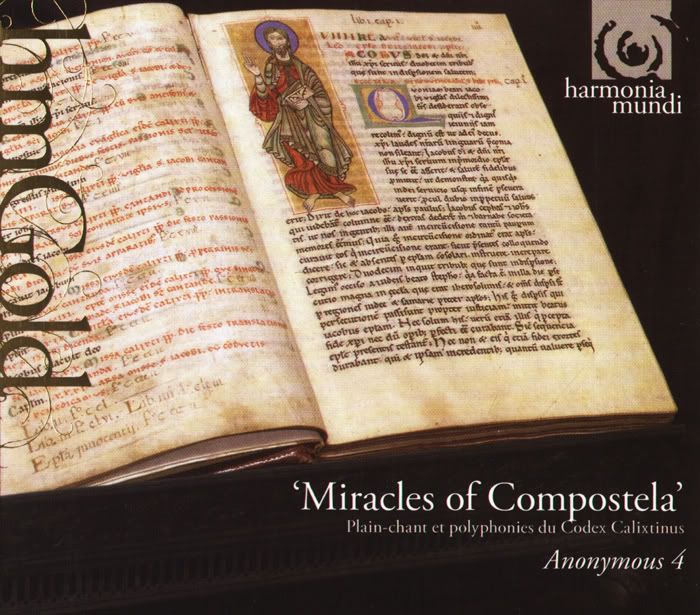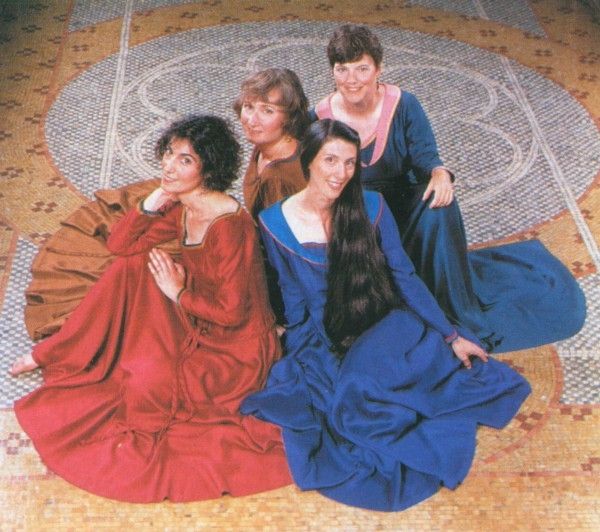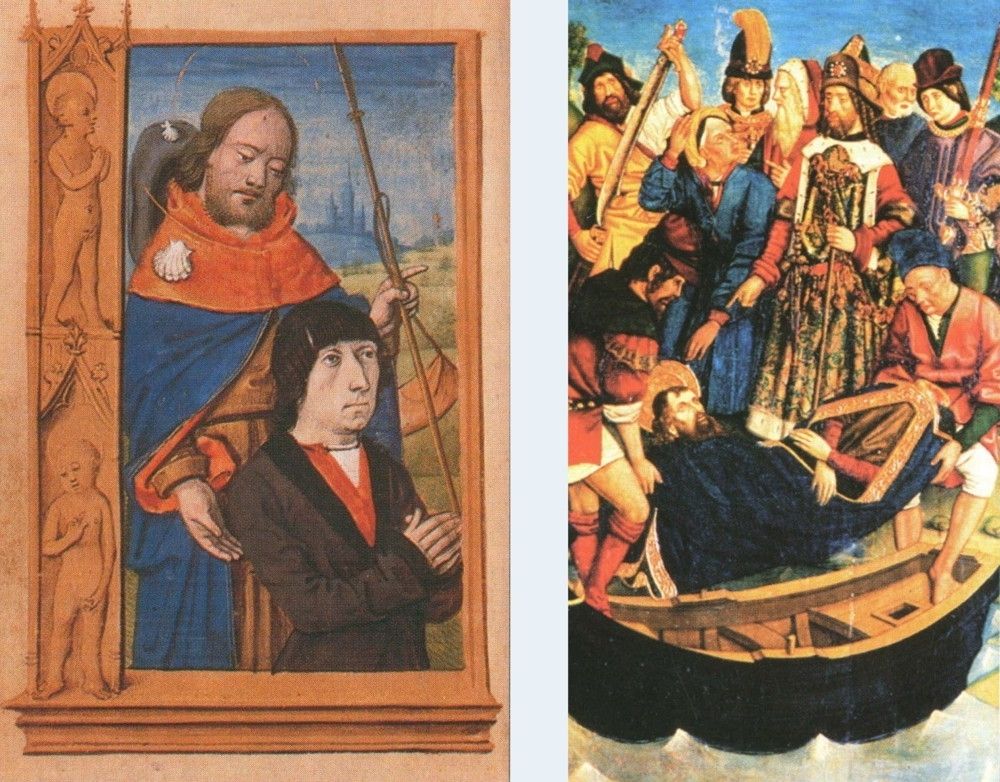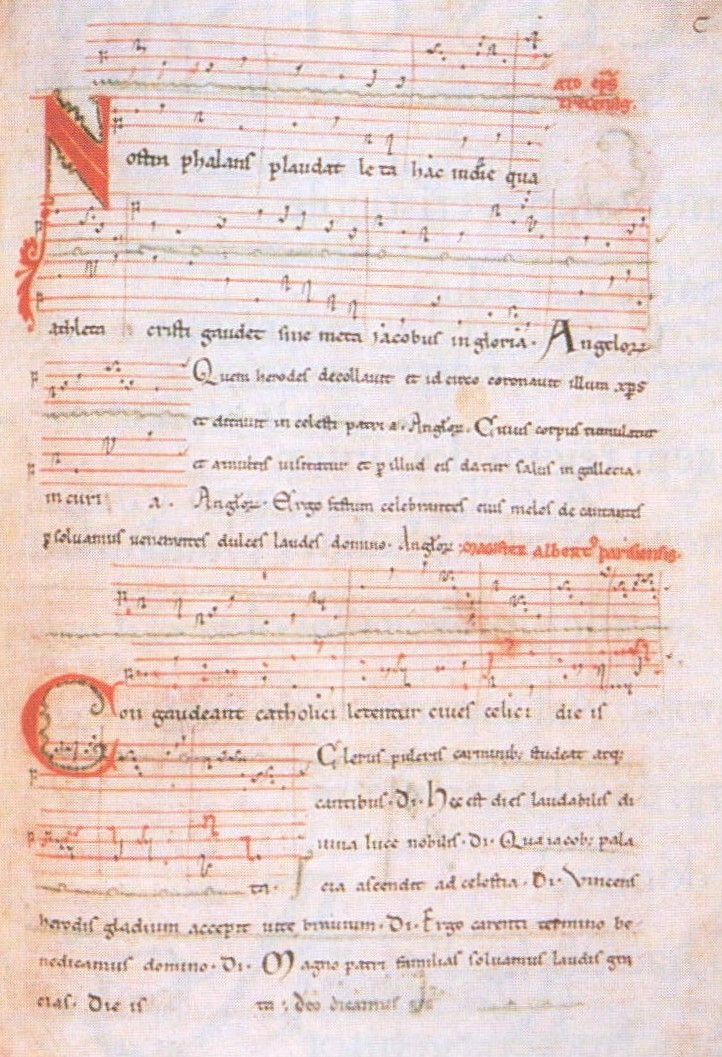
medieval.org
anonymous4.com
Harmonia Mundi HMU 90 7156
1995
2008: Miracles of Compostela
Harmonia Mundi "Gold" 507156


medieval.org
anonymous4.com
Harmonia Mundi HMU 90 7156
1995
2008: Miracles of Compostela
Harmonia Mundi "Gold" 507156

1. Invitatory. Venite omnes cristicole [1:16]
cc 25
[a beato calixto papa edita]
2. Processional. Salve festa dies [4:38]
cc 70
versus calixti pape cantandi a processionem sancti iacobi in solempnitate passionis ipsus et transalacionis eiusdem
3. Benedicamus trope. Vox nostra resonet [1:41]
cc 102
magister iohannes legalis
4. Invitatory. Regem regum dominum [0:50]
cc 1
a domno papa calixto ex evangelis edita
5. Benedicamus trope. Nostra phalanx plaudat leta [2:26]
cc 95
ato episcopus trecensis
6. Antiphon. Ad sepulcrum beati Iacobi [2:13]
cc 16
ad vesperas, verba calixti
7. Benedicamus trope. Ad superni regis decus [3:05]
cc 98
magister albericus archiepiscopus bituricensis
8. Brief responsory. Iacobe servorum [2:13]
cc 60
9. Benedicamus domino [1:54]
cc 112
magister gauterius de castello rainardi
10. Conductus. In hac die laudes [4:29]
cc 82
conductum sancti iacobi a domno fulberto karnotensi episcopo editum
11. Kyrie trope. Cunctipotens genitor [5:14]
cc 111
gauterius prefatus
Chant
form Bibliotèque nationale, Paris, ms. Lat 1112, with cadence formulas
modified to match those of the polyphonic setting in Jacobus
12. Hymn. Psallat chorus celestium [1:10]
cc 2
hymnus s iacobi a domno fulberto karnotensi episcopo editus
13. Prosa. Alleluia. Gratulemur et letemur [6:27]
cc 76
prosa sancti iacobi latinis, grecies et ebraicis verbis, a domno papa calixto abbreviata
14. Offertory. Ascendens Ihesus in montem [3:48]
cc 77
[Calixtus?]
15. Agnus dei trope. Qui pius ac mitis [2:24]
cc 93
agnus fulberti episcopi karnotensis
16. Benedicamus trope. Gratulantes celebremus festum [2:47]
cc 97
magister goslenus episcopus suessionis
17. Conductus. Iacobe sancte tuum [5:01]
cc 80
conductum sancti iacobi ab antiquo episcopo boneventino editum
18. Responsory. O adiutor omnium seculorum [8:36]
cc 106
magister ato episcopus trecensis
quidam antistes a iherosolimis rediens, ereptus per beatum iacobum a marinis pericul, in primo tono edidit hunc responsorium
19. Prosa. Portum in ultimo [2:42]
cc 107
prosa idem ato
20. Benedicamus trope. Congaudeant catholici [3:38]
cc 96
magister albertus parisiensis
21. Prosa. Clemens servulorum [4:49]
cc 78
prosa s iacobi crebro cantanda a domno guilelmo patriarcha iheroslimitano edita

ANONYMOUS 4
Ruth
Cunningham
Marsha Genensky
Susan Hellauer
Johanna Maria Rose
harmonia mundi usa (P C) 1995
Recording: July 25-28, September 20-22,1995, Campion Center, Boston, MA
Producer: Robina G. Young
Engineer: Brad Michel
Editing: Paul F. Witt
· Cover recto: Detail, showing St. James,
of twelfth-century frontal in the Museo Catedralicio, Orense, Spain;
photograph by Juan Manuel Moretón Brasa
· Cover verso: Fourteenth-century panel painting
by anonymous Catalan-Aragonese artist,
“Translation of the Body of Sant'Iago”
courtesy of Prado, Madrid, Spain
· Three illuminated letters from the Codex Calixtinus
reproduced from
José López-Calo, S.J., La música medieval en Galicia
(La Coruña, 1982); photographs by Constantino Martínez
· Codex Calixtinus, fol. 185 recto: Nostra phalanx & Congaudeant catholici
(Reproduced from the facsimile edition published by
Fotojae and the Centro de Estudios del Camino de Santiago;
photograph by courtesy of UCLA Music Library)
· Forster Book of Hours: Donor with St. James as Pilgrim (c. 1500)
(Courtesy of Victoria & Albert Musem and e.t. archive)
Photo Anonymous 4: Christian Steiner
Booklet design: Steven Lindberg

— Marilyn Stokstad, Santiago de Compostela: In the Age of the Great Pilgrimages
Copyright copy 1978 by the University of Oklahoma Press
During
the Middle Ages, three holy places — Jerusalem, Rome, and Compostela, a
remote Galician village in northwestern Spain — were visited by
countless pilgrims from all over Europe, often in fulfillment of a
lifelong dream. Compostela was the legendary burial place of St. James
the Greater, Jacobus Major, the first apostle, and the first to
die a martyr. For medieval Spain, under Moslem siege, St. James became a
heavenly champion and symbol of the Christian Reconquista. His
power as a miracle worker was renowned, and visitors to his tomb sought
both physical and spiritual healing, as they do to this day.
Since the late twelfth century the Cathedral of Santiago in Compostela has possessed a manuscript entitled Jacobus (and also called Liber Sancti Jacobi or Codex Calixtinus).
Its five books contain sermons on St. James, chants and lessons for his
feasts, accounts of his miracles and legends, an epic tale of
Charlemagne in Spain, an informative travel guide to the pilgrimage
routes through France and Spain, and a contemporary “supplement” of
polyphonic music. How it found its way to Compostela is not known for
certain, but it is undoubtedly a French product, probably compiled or
written in Cluny around 1150. Although its author was obviously erudite,
Jacobus contains many ridiculous errors in grammar, rhetoric,
and dogma, which scholars have tried for centuries to rationalize. It
has recently been shown that the non-musical portions containing these
errors were actually texts to be corrected by French schoolboys as
Latin exercises, and that the music (which is not defective) was meant
to be sung by the boys on feasts of St. James.*
About ninety percent of the music in Jacobus
is plainchant for the Vigil and Feast of St. James (25 July) and for
the Translation of his body from Palestine to Galicia (30 December).
Most of it is specifically liturgical: hymns, antiphons, responsories,
and versicles for the Divine Office and Mass propers and ordinaries.
Many, if not most, of these were contrafacts (i.e., adapted from
existing chants), such as the invitatory antiphons Venite omnes and Regem regum, the processional hymn Salve festa dies, and the antiphon Ad sepulcrum beati Iacobi. Other chants, like Agnus dei: Qui pius ac mitis,
were expanded, or “troped” with additional text and music, and it was
perhaps as an educational gesture that Greek, Hebrew, and Galician words
were added to the ancient double-versicle “prosa” Alleluia: Gratulemur et letemur.
Although they represent a mere ten percent of the music in Jacobus,
the polyphonic works (nineteen for two voices, one for three voices)
have received more attention from scholars than the plainchant has
because they are among the earliest such pieces to have been written
down. Some, like the conductus In hac die and Jacobe sancte tuum,
are not strictly liturgical, but are perhaps meant to accompany a
reader’s walk to the lectern. Several others are settings or tropes of
the Benedicamus domino, a closing formula of the Office and Solemn Mass, such as Vox nostra resonet, Nostra phalanx, Ad superni regis, Gratulantes celebremus, and Congaudeant catholici.
This last piece was originally notated in two voices, with a third
voice added in a different hand — making it one of the earliest
surviving three-voice pieces. Because this third voice creates many
dissonances, some scholars say that only two voice parts should be sung
at a time. We think, however, that it makes a very satisfying
three-voice piece, just daring enough for an “avant-garde” work of its
time.
Most of the musical works in Jacobus are attributed
in the manuscript to specific (usually French) authors — clerics and
other notables, some famous and others unknown. Until recently it was
thought that these attributions were fanciful, but research has verified
many of them. For plainchant works based on existing melodies, these
authors probably wrote new texts, often drawn from St. James’s copious
miracle literature rather than from scripture. For polyphonic works,
these authors may have been responsible for the music and text, or for
the music alone. The greatest number of polyphonic settings by a single
composer, including the monumental responsory O adiutor and its trope Portum in ultimo, are those of Bishop Ato of Troyes, who retired to Cluny in 1145 — just about the time when Jacobus was assembled.
There
are two distinct textures for the polyphonic works: a “discant” style,
in which the two voice parts generally move together (as in the
conductus and the Benedicamus tropes), and an “organal” style in which
the upper voice part sings a rhapsodic melody against the long-held
notes of a lower tenor voice based on a liturgical chant (as in O adiutor and the troped Kyrie: Cunctipotens).
The plainchants most commonly set in this way are the soloists’
portions of the Gradual and Alleluia of the Mass, and the Matins
Responsory of the Divine Office. In hindsight, it is possible to see
this style, with its relatively simple textures and limited liturgical
repertoire, as a primitive precursor of more sophisticated developments
to come. But the polyphonic compositions that survive in Jacobus are representatives of a highly developed musical language. Just about a generation after the appearance of Jacobus,
the basic elements of this language — its vocal textures and its
repertoire — came together again in the first Notre Dame school of
sacred polyphony, led by Leoninus.
The notation in Jacobus
is ambiguous as to rhythm and meter, as well as to alignment of pitches
between the voice parts in the polyphony. Scholars have proposed a
variety of rhythmic solutions for the polyphony and the non-liturgical
songs, ranging from an unmeasured chant-like style to strictly regular
“modal” rhythm. Instead of adhering to any previously existing theory,
we have come to our rhythmic interpretations by considering not only
melodic, harmonic, and notational patterns, but also the nature and
poetic structure of the texts themselves. In imitation of contemporary
instrumental practice, we have occasionally added vocal drones as well.
As our guiding principle we have tried to be true to the infectiously
joyful and exuberant melody that pervades this remarkable collection,
made for and performed by the young treble voices of a medieval French
grammar school.
— Susan Hellauer
* Christopher Hohler, “A Note on Jacobus”, Journal of the Warburg and Courtauld Institutes, XXXV (1972), pp. 31-80.
